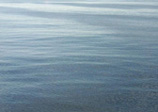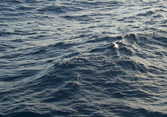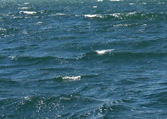 |
 |
 |
| The roughness of the sea surface
strongly influences air-sea exchange processes. At low
to moderate wind speeds, naturally- occurring surface
films damp small-scale waves and turbulence that promote
transfer of heat and gases. |
|

The
Air-Sea Interface
The boundary between atmosphere and ocean
is a region of intense interest to marine
scientists studying processes of heat, mass and
momentum transfer and their impact on such important topics
as upper ocean mixing and circulation, weather
and climate.
My own research
interests center on the chemistry and physics
of the sea surface microlayer, roughly defined
as the top millimeter of the ocean surface. This is a
regime differentiated from the underlying water
by its chemical composition, biota, and physico-chemical
properties. Surface-active organic compounds
accumulate at the air-sea interface and influence
the small-scale wave field and near-surface
turbulence. Processes such as heat and gas transfer,
which are strongly dependent on generation of
turbulence by wind stress and wave breaking mechanisms,
are modulated by these natural surfactant films.
Much of my recent
research has involved understanding the
relationship between sea surface roughness and gas
transfer rates. Since surface roughness can be measured
by microwave devices on satellites, I am also interested
in developing remote sensing algorithms to determine
regional and global gas transfer velocity fields
using radar backscatter from altimeters and scatterometers. |
|